Conventional methods of farming and livestock management practices have long known to be a manual labor-intensive industry. With modern technology such as the Internet of Things revolutionizing many industrial sectors such as manufacturing, logistics, healthcare, etc., its influence and role in modernizing techniques and practices in the agricultural sector need no introduction.
Drawbacks of traditional farming practices
Traditional farming adheres to overused and outdated practices and equipment for farming and livestock management. This has contributed to low crop yield and low-input husbandry.
The Food and Agricultural Organization (FAO) of the United Nations has predicted a population spike of about 8.5 billion by 2030 and 9.6 billion by the year 2050. The rising figures in the years to come would demand food production to increase by 70%. However, the scarcity of agricultural lands, limited water resources, and drastically changing climate patterns would pose a challenge to meeting the growing demand for food and nutrient resources in the coming years.
With the advent of IoT in Agriculture, several efforts are being set in place to improve the 'Quantity & Quality' aspects of food production and livestock management by turning them connected and intelligent. IoT in Agriculture has achieved this through Smart farming.
When Farming Practices and Technology Come Together
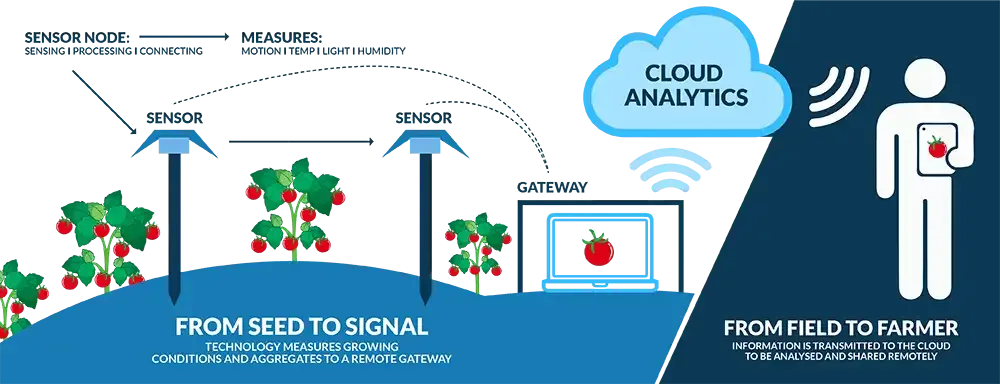
Smart farming, often referred to as the '4.0 Green Revolution', integrates agricultural methodologies with cutting-edge technology, epitomizing the essence of IoT in agriculture. This progressive approach is transforming the landscape of farming by utilizing the Internet of Things (IoT) to enhance efficiency and productivity in agricultural practices.
The Role of Technology in Smart Agriculture
In the realm of smart agriculture, technology plays a pivotal role by incorporating various sophisticated tools such as sensors, actuators, communication networks, and data analytics. These technologies are essential for implementing IoT in agriculture, facilitating precise control over farm operations. This includes the ability to monitor crop growth, manage irrigation and fertilizer use, and ensure the health and well-being of livestock through continuous monitoring and data-driven decisions.
IoT-Based Farming Processes
The core of IoT in agriculture lies in the deployment of IoT devices across farms. These devices continuously collect data, offering real-time insights into various aspects of the agricultural environment. From soil moisture levels to atmospheric conditions, IoT sensors provide farmers with the critical information needed to optimize their farming strategies and enhance productivity.
Farming Practices and Technologies
Radio Frequency Technologies
Within the scope of IoT in agriculture, radio frequency technologies like Bluetooth Low Energy (BLE) and Wi-Fi are typically used for indoor monitoring, such as in greenhouses or indoor smart farms. For more expansive outdoor farms, long-range technologies such as GPRS and LPWAN are preferred due to their ability to cover larger distances. BLE mesh technology further extends the capability of these networks, ensuring connectivity across various farm locations without direct line-of-sight to network nodes.
Mesh Network for Enhanced Connectivity
The implementation of a BLE mesh network is a prime example of IoT in agriculture enhancing connectivity. This network allows data from sensors spread across a farm to be relayed to a central device connected to a Cellular LPWAN. This device then transmits the data to the cloud. Such a setup ensures that even remote areas of a farm are well-connected, providing seamless data flow and enabling efficient farm management.
Hybrid Core Network
The hybrid core network, supported by mesh topology, addresses the common challenge of connectivity range in rural farming areas. It works in tandem with cellular LPWAN technology to create a robust network of interconnected devices. This network structure supports the essence of IoT in agriculture by ensuring that data from various farm locations is consistently collected and transmitted, despite the physical distances between these locations.
Energy Management in IoT Devices
Energy efficiency is crucial for sustainable agriculture. Modern low-power sensors and solar-powered devices play a pivotal role in maintaining continuous and eco-friendly operations. These innovations help reduce energy consumption while maximizing data collection and analysis, making smart agriculture using IoT both practical and environmentally responsible.
Additionally, the integration of IoT in agriculture with advanced machine learning algorithms can further optimize energy usage. Predictive analytics can anticipate energy needs based on historical data and environmental conditions, ensuring efficient resource utilization. By combining IoT with renewable energy sources like solar and wind power, smart agriculture systems using IoT can enhance sustainability, significantly reducing the carbon footprint of farming operations while maintaining high productivity.
Get Our Smart Agriculture Guide for Advanced Farming Techniques!
IoT applications in Agriculture
Agricultural IoT applications such as smart irrigation, precision farming, disease forecasting, cattle health monitoring solutions, etc., are expected to achieve wide traction to meet the rising resource demands in the years to come.
Below are the top six areas of innovation in farming technology demonstrating how IoT has headed towards reshaping the agricultural landscape:
Environment & Micro-climate tracking
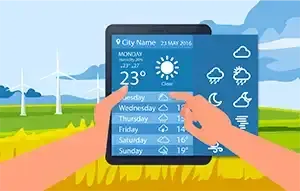
As compared to its traditional counterpart, IoT-enabled weather stations use wireless units to track and provide micro-climate data. Such data can alert farmers on harsh climatic conditions and allow them to take necessary actions in preserving crop health and sustenance beforehand.
Real-time asset monitoring
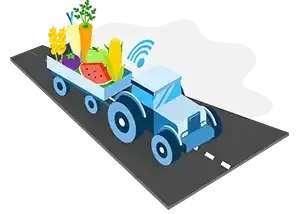
Farmers needn't conduct an onsite inspection of crops, feed tanks, ponds, and cattle farms as IoT-enabled monitoring technology allows farmers to keep remote track of resources, usage rates, perform field inspections, and direct and manage delivery truck schedules, etc.
Cattle Tracking
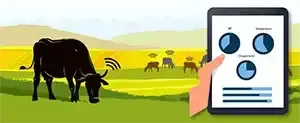
Network-connected collar wearables can track cattle movement and notify farmers of trespassing, thereby preventing cattle loss or theft. Farmers can also monitor eating patterns and health-related activities with a leg- or neck-mounted sensor to efficiently identify and monitor health issues.
Driverless machines
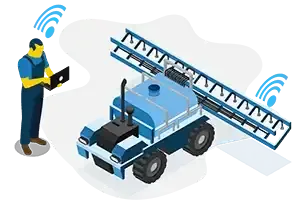
With the inception of machine automation, agriculturalists have found new ways to automate their equipment through IoT-powered driverless machines to bring automation to the next level. With lightweight driverless machines, farmers can cut back on labor costs, reduce failure, and minimize machine downtime.
Mobile Weather Stations
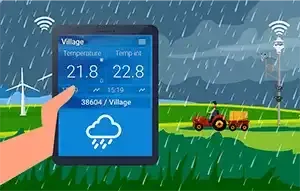
IoT-enabled mobile weather stations provide meteorological data regarding incident response, mobile air traffic control, and command and control. These are quick to set up and can begin to record data for incident decision-making automatically.
Precision Farming
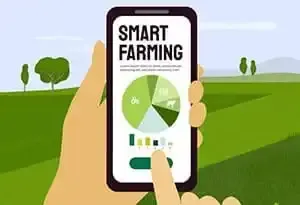
This approach uses IoT-based devices to timely and accurately address the needs of cattle or plants with precise nutrient/fertilizer additions, monitor individual animals' well-being, and identify herds falling ill, allowing farmers to take effective and necessary actions.
Cavli’s solutions powering smart farming and real-time livestock management
Cavli, with our solutions in smart connectivity enablement, is working with different stakeholders in Agriculture IoT to ensure they build reliable and scalable alternatives to traditional solutions without much overhead cost.
Cavli's IoT enabling solutions offer reliable and scalable solutions to enhance your farm's productivity by improving:
Crop Yield
![]()
Solutions to detect crop anomaly avoiding the risk of losing yield
Product Quality
![]()
Have better control over the production process & maintain higher standards
Business Efficiency
![]()
Intelligent help automate multiple processes
Download Our Livestock Monitoring Guide to Enhance Animal Care and Productivity!
Power Your Cattle Health Monitoring Solution with Cavli’s LTE IoT Modules
Cattle health monitoring solutions typically involve connected wearables mounted around the animal's neck or leg. These devices allow farmers to track livestock health, preventing disease outbreaks and ensuring animals stay within designated areas.
C41QS NB2/NB1 IoT Module
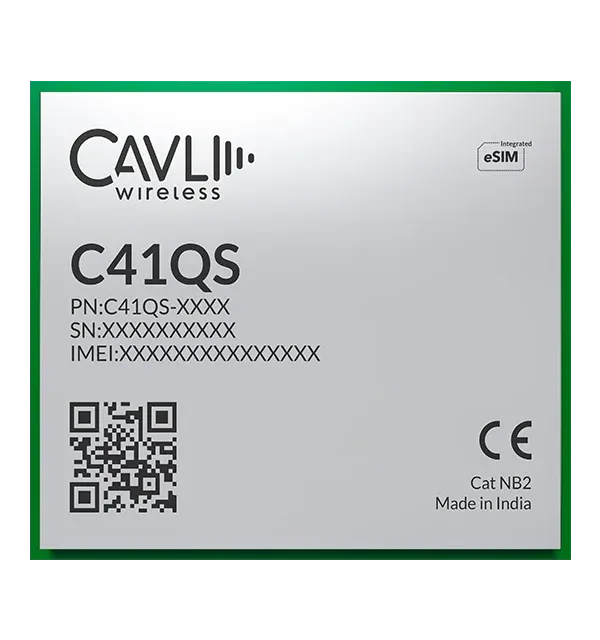
The C41QS is part of Cavli’s NarrowBand-IoT platform, featuring low power wide area network (LPWAN) technology. Compatible with 3GPP E-UTRA Release 14 standards, it supports global frequency bands and offers low power consumption. Its compact size (17.7mm x 15.8mm x 2.0mm) makes it ideal for space-constrained applications. Optional integrated GNSS and eSIM provide global connectivity and device management via Cavli’s Hubble platform. It ensures that OEMs can develop reliable animal monitoring solutions with the extended coverage available through NB-IoT networks. The C41QS is a very power-efficient module with a compact form factor that can be easily incorporated into space-constrained applications like cattle tracking and monitoring solutions.
C42GM LTE Cat M1/Cat NB2/NB1 IoT Module

The C42GM module adheres to 3GPP Release 14 specifications and supports LTE Cat M1/Cat NB2/NB1. Its compact design (26.5 x 22.5 x 2.3 mm) and ultra-low power consumption are ideal for IoT applications. The module includes global band support, integrated GNSS for tracking, and an eSIM powered by the Cavli Hubble platform. This module has versatile options for network connectivity, ranging from LTE-M to NB-IoT. LTE-M provides high data bandwidths, but the module can easily switch to NB-IoT in case of coverage issues, offering superior coverage even in remote deployment scenarios.
C16QS LTE Cat 1bis IoT Module
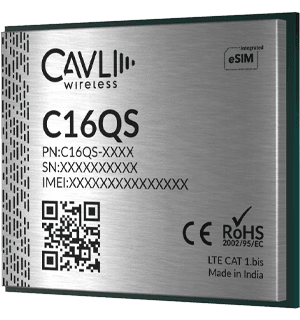
The C16QS series complies with 3GPP Release 14 and is designed for IoT and M2M applications. It offers optional GNSS for location tracking and an integrated eSIM for global connectivity through the Cavli Hubble platform. This module is ideal for transitioning from 2G/3G to LTE, with features like independent LTE and GNSS power supply, sleep modes, and low power modes. While not part of LPWAN, the C16QS is the ideal low power IoT module as it combines the speeds of LTE networks with low power draw requirements. Power Saving Modes and sleep modes ensure longer device lifecycles for battery-operated use cases, ensuring optimum performance in applications like cattle monitoring and tracking solutions.
Using Cavli’s IoT modules, health parameters such as temperature, blood oxygen levels, and ECG can be collected by embedded wireless sensors. This data is transmitted over cellular networks to a data cloud for processing, giving a clear picture of animal health. Farmers can visualize this data along with location tracking remotely through application software, enabling timely actions to prevent illnesses and prevent runaway scenarios.
Cavli’s robust NB-IoT/GPRS modules offer durability and longevity for smart applications, making them the ideal power engines for advanced cattle health monitoring solutions. With features like ultra-low power consumption and the latest IoT technology, Cavli’s modules ensure efficient and reliable performance in the agricultural sector.
Why IoT is Predominantly Used in Agriculture
IoT is mainly used in agriculture to increase efficiency, reduce costs, and ensure sustainable farming. The ability to monitor and manage farming operations remotely and in real-time makes IoT an invaluable tool for modern agriculture. IoT technologies enable farmers to optimize resource use, improve crop and livestock management, and enhance overall productivity. By leveraging IoT, farmers can achieve higher yields, reduce waste, and contribute to a more sustainable and resilient agricultural industry.
Conclusion
In the coming years, where agriculture and livestock farming eye an ongoing future together with the Internet of Things, an unprecedented level of control and automated decision-making is expected to rise. This could potentially lead to a Third Green Revolution, where an enduring ecosystem of innovation in the agricultural sector will begin to unfold. IoT technologies will enable better food production, management, and traceability. This is expected to be beneficial for the global environment where natural resources like water and nutrients are efficiently and carefully consumed, which will be essential for mankind's continual survival for the years to come.